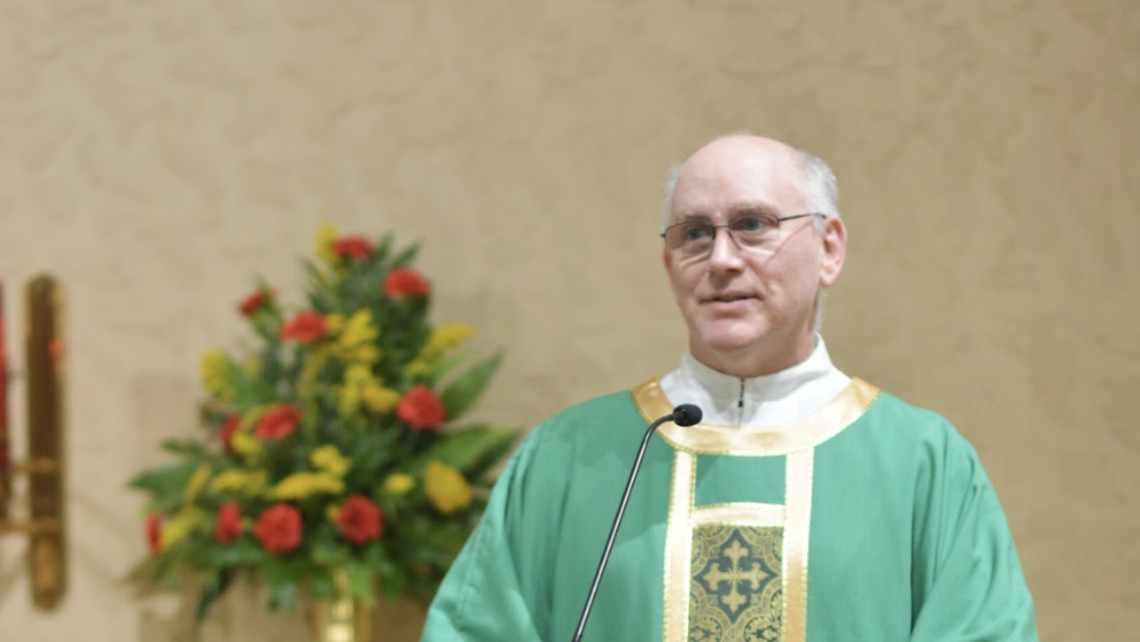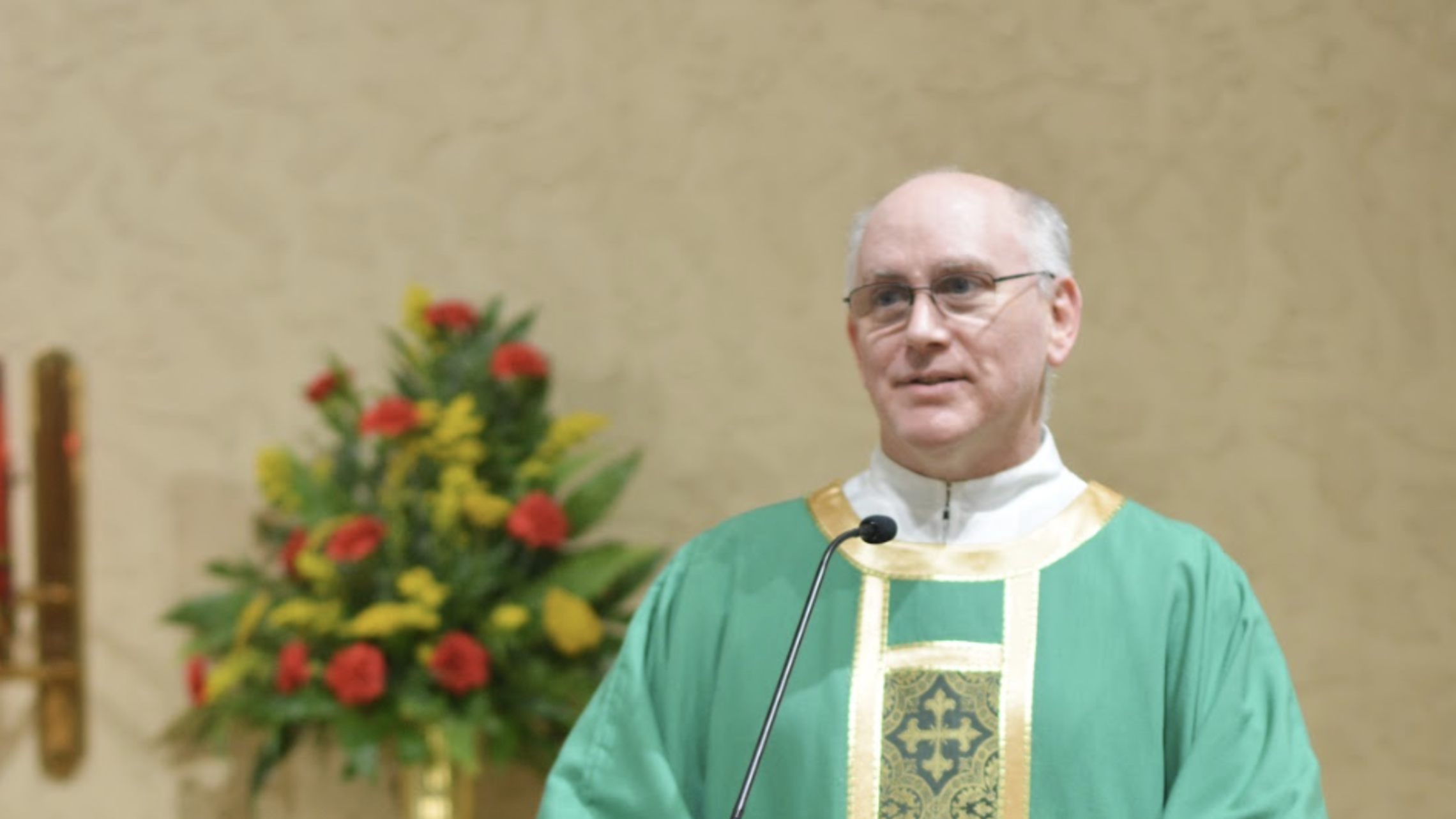
Holy Thursday Evening Mass of the Lord’s Supper
Exodus 12:1-8, 11-14; 1 Corinthians 11:23-26; John 13:1-15
My family and I had the great privilege last summer of visiting Italy, and while in Milan we were able to get tickets to see one of the most famous paintings in the world – The Last Supper by Leonardo DaVinci. It is one of the most copied works, both in DaVinci’s own time as well as today, and I’m sure most of you have seen reproductions of it. Even though it has deteriorated significantly over the years, it is still a marvel to look at – each tour group is given ten minutes to look at it before they are ushered out and a new group is allowed in. We are all so used to seeing its depiction as the definitive image that most artists use as the standard of the Last Supper that we forget to ask the obvious question: why is everyone sitting on the same side of the table? Do you do that at your house at Thanksgiving? Hey everyone, let’s all sit on the same side of the table while we eat. No, of course not. It is obvious to even someone as untrained in art as I am that it was done for artistic effect of being able to see all twelve of the Apostles as well as Jesus clearly, with all the facial features that Leonardo was a master at. But this odd fact made me start thinking about something that links together two of the important aspects of today's Mass of the Lord’s Supper – the institution of the Eucharist and the institution of the ministerial priesthood.
The first of these two, the Eucharist, is rather straight forward. The Last Supper is linked in all our minds from childhood with Holy Thursday, the night before he died. I would like to spend some time today discussing the second of the two, the ministerial priesthood.
A priest is ordained first and foremost to administer the sacraments, and of the sacraments the Eucharist remains the source and summit of our faith. In the early church, the Apostles were the leaders of the small body of disciples of Christ, but as the Church grew, they were not able to do all their tasks, so they laid hands on – that is to say, ordained – men who helped them carry out the various worship and pastoral activities that were necessary in the new towns where The Way, as early Christianity was called, was beginning to be practiced. Priests, also called presbyters from the Greek for elder, were called on to perform the sacraments. Deacons were called to assist in serving the priests and the community. We have retained this structure until modern times, with the bishops being the direct successor to the Apostles, as the leaders of the Church, and priests filling in for the bishop to administer the sacraments and lead at the faithful at the local churches.
The Catechism puts it this way: “the members [of the Church] do not all have the same function. Certain members are called by God, in and through the Church, to a special service of the community. These servants are chosen and consecrated by the sacrament of Holy Orders, by which the Holy Spirit enables them to act in the person of Christ the head, for the service of all the members of the Church. The ordained minister is, as it were, an "icon" of Christ the priest. Since it is in the Eucharist that the sacrament of the Church is made fully visible, it is in his presiding at the Eucharist that the bishop's ministry is most evident, as well as, in communion with him, the ministry of priests and deacons.” [CCC 1142 https://www.vatican.va/archive/ENG0015/__P37.HTM ]
This passage references the letter of Saint Paul to the Romans, where he talks about the Body of Christ being like a physical body, where every part – the head, the hands, the legs, and so forth – all are different and have a unique role but are all essential to the body functioning as a full human being. [Romans chapter 12] So the clergy, as the head, lead but are no more important than any other part of the body, all of which are necessary.
Which brings me to my earlier point, about being on the same side of the table. Pope Benedict, in his book The Spirit of the Liturgy [San Francisco: Ignatius Press, 2000, chapter 3], which he wrote when he was still a cardinal, argued for returning to the practice which was common before the Second Vatican Council of ad orientum, which is when the priest stands on the same side of the altar as the congregation during the prayers of Eucharistic consecration. The advantage of doing it this way, the soon-to-be-pope argued, was that all of the faithful, priests, deacons, as well as all the people, together faced our Lord together, all looking east, the direction that early churches were built, all looking upon the bread and wine, the altar, the crucifix, and the tabernacle, as one body of Christ. This is symbolic unity, since the celebrant is in union with the worshiping community no matter what way he faces, but there is symbolism in many things we do in our liturgies that carry theological merit. And it is why at all Holy Hours the presiding priest or deacon will come and kneel or sit in the pew area with their fellow adorers, all facing the altar and the monstrance together. We are all one Body of Christ adoring Christ in the blessed sacrament. The presider is the leader of the prayer, certainly, and will do the benediction blessing as part of his ordination faculty of giving blessings, but otherwise is just an adorer like all others looking on. The priest should not be the center of attention at any point, but any liturgy, including Mass and Holy Hours, must always focus exclusively on God.
There are those that argue that, for the advantages of an ad orientum arrangement of a church, the more common versus populum also had some advantages. The obvious one is that the lay people can see the consecration more easily. The Roman Missal, the official book of the Church that father reads from, although you cannot see them, has many instructions about things that the priest celebrant is to do as he says the Eucharistic Prayer. By facing the people, we can all see them clearly. At all times of the consecration and the breaking of the bread, we can all see it, understand what’s going on, and let it be a part of the Eucharistic Adoration we do as part of our prayer life. Adoration is not separate from the Mass but is an integral part of it.
In addition, during the Mass the priest celebrant is performing the Liturgy of the Eucharist “in persona Christi,” Latin for “in the person of Christ.” Jewish priests in the time of Jesus performed the sacrifices of animals on the altar in the temple required by Mosaic law. Catholic priests today act in persona Christi while they bless, break, and give the bread and wine as Christ instructed us to do, as recounted by Saint Paul in the second reading, “in remembrance of me” [1 Corinthians 11:24b NABRE]. Christ the priest made the perfect sacrifice of himself on the cross to the world. Catholic priests, in persona Christi, make this memorial sacrifice in the Eucharist on the altar of our church. Hence we have today's celebration of the institutions of both the Eucharist and the ministerial priesthood.
Now I’m not making any arguments today for any church changing the way they have arranged their altar – whether we are all on one side of it or not. It turns out that both ad orientum and versus populum were both allowed before Vatican II, although ad orientum was the most common, and both are allowed after Vatican II, with versus populum now more common. I personally prefer our current arrangement, finding that the ability to see what’s going on is a more important value, but I understand that people of good will might weigh the scales differently. What I would recommend is that no matter what method is used – and you might very well visit a church when you travel that is using the ad orientum altar arrangement – that you appreciate what it brings to the Mass and take full advantage of it in your sacramental life.
As we continue with the Mass, let us all focus on all aspects of the Liturgy of the Eucharist – with its carefully worded prayers, actions, and symbolism – to truly be able to adore our God and be worthy to receive him into our lives. Let us pray for Father Oscar and all priests, that they may be blessed for their lives of service and be worthy to stand in persona Christi. We are not all on the same side of the altar, but may we all stand on the same side of what is good, true, and beautiful in this world, adoring Christ and faithfully bringing his teachings into the world.

